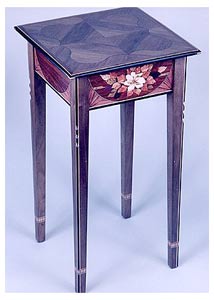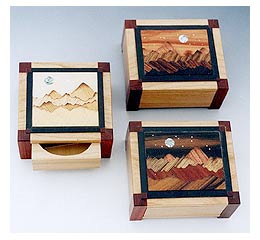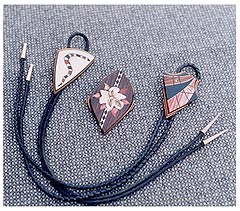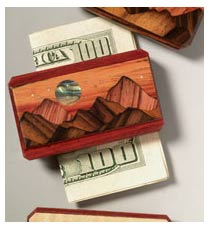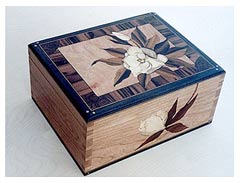
“My aim in woodworking,” T. Breeze Verdant told me, “is to create the greatest amount of beauty while consuming the smallest amount of wood.”
Yes, that is his real name, and yes, he does what he aims to do by creating beautiful marquetry boxes, furniture and jewelry using mostly recycled wood and cutoffs. Marquetry is the art of inlaying veneers to create pictures and images, and Breeze approaches it with both creativity and conservation.
“I work primarily with cutoff scraps that I buy by the pound. This enables me to use exotics without adding substantially to the problem of rainforest depletion or wasting resources. I respect the wood I work with and regard it as a precious resource. By using veneers, I can get vastly more wood beauty while using up less wood.”
Working with small, delicate pieces is his hallmark now, but his earlier exploits with wood involved some much larger chunks. “My father was the largest rep for the largest contractor selling chalkboards,” Breeze recounted, “and I used to help him with installations. I took shop in high school and loved it more than any other subject, and decided early on that I wanted to make my living creating something. After high school I went to college for a year and a half and studied business management at my family’s behest, but that was clearly not the right path for me. I never did well in school, and took miscellaneous jobs after that.
“In 1974, I built a log cabin from some of the trees on a piece of property I owned near Lake George, New York. That was really my first woodworking experience. I did it the hard way, dropping trees and trying to haul 30-foot green logs by myself with a come-along in 10-foot increments. I was like a human mule, but it left me in good shape physically. During that time, my future wife supported me. We then bought another piece of land and once again I built a house, this time ripping the logs into lumber and drying them before building.
“After spending my 20s building, I went to massage school in New Mexico when I turned 30, but by 1984 I started working as a trim carpenter in Florida. In addition, I worked in a cabinet shop, and during that time built another house using mostly reclaimed materials. Throughout these years, I also played music, both alone and in a band, sometimes for money. Music was always a big part of my life, but traditional art was not. It never dawned on me that I could be an artist.” That changed thanks to the suggestion of a friend.
“The wife of the cabinet shop owner was a weaver, and she told me about Penland School, where I took a class with marquetry expert Silas Kopf. I have been doing marquetry ever since. By then I was 37, and frankly, it took me years to figure out that what I had been doing all along was a form of artwork.
“I don’t consider myself a woodworker, but rather an artist. It is not that woodworkers are not artists, it is just that I am extremely right brain. I don’t talk about tools; they are just things to allow me to make what I want, and it would be tough for me to figure out things like straight-line joinery. Once I realized this, I looked back and saw that the signs had always been there. Even back when I mowed lawns as a kid, I would mow in diagonals and circles instead of straight lines.
“I’ll sometimes go out into the woods and cut things like the forks of trees into veneer, or cut ‘oysters,’ cross grain cuts of branches, often cut diagonally, to use in inlay work. At times the wood suggests its use. I recall one piece of wood with a lot of iron in it that showed an intense swirling pattern when I cut through it. I cut the piece into mirror images and set it in a black veneer with colobolo on both sides to bring out the nautilus pattern.
“For the most part, I enjoy creating artwork in wood and on wood,” Breeze explained. “As long as I have something to reach for and something I can picture, it will keep me actively engaged in the creative process. I like to start my work with a basic foundation but one that lets me take off in whatever direction the artistry takes me. I like playfulness and spontaneity. That is my passion.”
These days, Breeze makes small, regularly selling items like money clips, boxes, and wooden jewelry as bread and butter production. The small items mostly sell wholesale through galleries, but he also does furniture and even guitars. “Furniture is tough for me because I prefer working small,” he admitted. “The furniture pieces are as much palettes for inlay as anything else.
“My capacity for detail and my imagination often combine to exceed the amount of time I am willing to devote to a project. Big projects are too involved and require too much of an investment in time. It takes too long to manifest an idea, whereas small boxes let me follow my creative ideas quickly. In part, that has kept me from doing much furniture. Besides, I am economically humble, and don’t like the idea of charging people the sort of money that would be required to launch me into doing large, high-end pieces.”
His music has also been a major part of his life, and it, too, crosses over into his marquetry. “About seven or eight years ago I approached the Carvin guitar company and offered to do inlay on some of their guitars. I had done one guitar on my own, and realized I would rather do inlay than build the whole guitar. I did four designs for them, and have done 19 guitars so far.”
Like many who have gained the respect of the woodworking community, Breeze shares his skill by teaching it. “For the past eight years,” he told me, “I have taught at the John C. Campbell Folk School in North Carolina. When I am teaching, it is the only time that I feel I sound smart, and I love teaching. Occasionally, I will teach in my own shop on a one-on-one basis.”
For Breeze, his greatest challenge and finest reward comes when it is time to part with his creations. “When I make something that I look at and get the feeling ‘this is just so beautiful that I can’t sell it,’ then I know I have hit the mark. When I have a hard time letting go of it, I know it is on target.
“Fortunately,” he says with satisfaction, “that happens a lot.”
